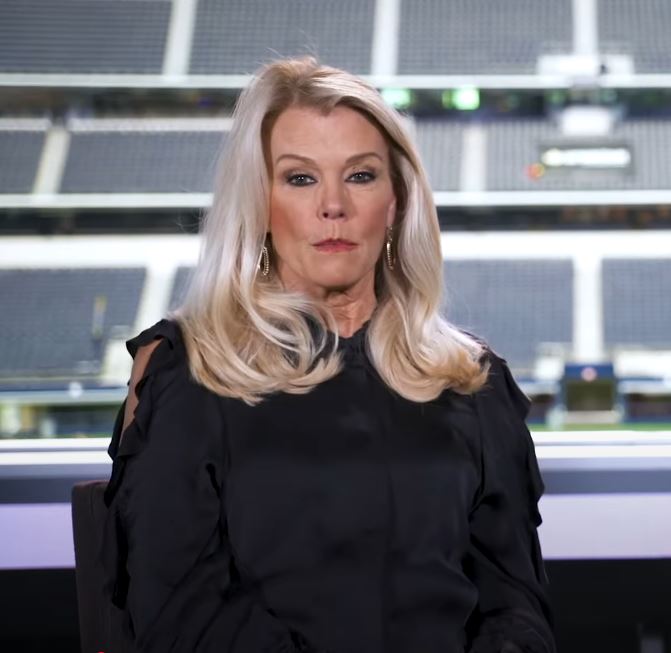Judy Trammell has quietly choreographed her way into American sports history over the last forty years. She has influenced perceptions as well as performances, whether on the Dallas Cowboys’ sidelines or on reality TV. However, there is still controversy surrounding her pay despite her significant cultural influence. Her estimated yearly salary as of mid-2025 is $68,555, which is a respectable amount but seems especially low in comparison to the NFL’s enormous financial power.
Early in the 1980s, Judy spent four seasons as a cheerleader, where she immediately distinguished herself for her ability and leadership. She rose through the ranks to assistant choreographer in 1984 and head choreographer in 1991, spearheading the squad’s movement. She probably approved every power move, hair flip, and coordinated high kick that has been performed over the last 30 years—carefully planned, practiced, and executed in front of a stadium. She plays a modest part. It is fundamental.
Judy Trammell – Personal and Professional Snapshot
| Category | Information |
|---|---|
| Full Name | Judy Carol Tharp Trammell |
| Date of Birth | April 29, 1958 |
| Age | 67 |
| Hometown | Dallas, Texas |
| Education | R.L. Turner High School |
| Occupation | Head Choreographer, Dallas Cowboys Cheerleaders |
| Career Start | DCC member (1980–1984), Choreographer since 1984 |
| Estimated Salary | $68,555 annually (based on ZipRecruiter data, 2025) |
| Net Worth | Estimated at $1.6 million |
| Family | Married to Dick Trammell; three children including Cassie Trammell |
Using her special combination of jazz-based performance training, drill team accuracy, and televised flair, Judy has choreographed for a number of well-known performers, such as Jessica Simpson, Reba McEntire, and Destiny’s Child. Her work has appeared in cheerleading competitions, music videos, and major award shows. Nevertheless, one of the few entertainment industries where influence seldom translates into pay is the NFL cheer squad.
Conversations about compensation have been rekindled in recent days by Netflix’s America’s Sweethearts series, which specifically brought attention to the disparity in pay between the leadership team and cheerleaders. Rookies used to only make $15 per hour, but after a historic 400% pay increase, their current hourly wage is closer to $75. It has taken a while for this change to occur. It was a long-overdue correction for many. However, it also brought up a follow-up query: what does it mean for the top salaries if the cheerleaders recently received a significant raise?
Although Judy’s estimated income indicates a comfortable lifestyle, it is by no means an elite one. In contrast, the $160 million contract of Cowboys quarterback Dak Prescott would more than cover the salaries of the entire DCC program. According to reports, NFL mascots have even made more money than individual cheerleaders. Even though Judy’s job is paid and more stable, it still seems to lag behind similar roles in the sports entertainment sector.
Judy has contributed to the DCC brand’s longevity for decades by working with her longtime friend and fellow leader, Kelli Finglass. As Director, Finglass has played a key role in increasing revenue streams via televised programming and sponsorships. Their camaraderie, which stems from years of sharing locker rooms and arduous wins, has resulted in a leadership style that is reliable and incredibly effective. Even though they work in the background, their impact is evident.
Finglass has made sure the team stays visible and marketable by forming strategic alliances. Contrarily, Trammell has concentrated on the performance aspect, fostering the brilliance that keeps viewers riveted to their screens. Judy’s pay, however, continues to reflect the underappreciation of women in artistic leadership despite her crucial role. Although her choreography is shown on national networks, her financial and other forms of recognition have frequently lagged behind.
Judy’s duties during the pandemic went beyond her regular duties. While preserving the vigor and discipline that characterize the Cowboys cheer brand, she modified practices, updated formations for online audiences, and guided dancers through adversity. Despite decades of service, her ability to adapt has been incredibly successful in upholding tradition without opposing change.
Judy’s story also illustrates how dance is passed down through the generations. Former cheerleader Cassie is now the head of the Junior DCC, a program that aims to inculcate the same values of excellence, discipline, and teamwork that influenced her mother’s professional life. Seeing Cassie continue in her footsteps gives Judy’s legacy—which is based on both private influence and public performances—an emotional component.
Given the growing debate over fair compensation in the entertainment industry, Judy’s pay raises questions about how we value positions involving mentorship and creativity. Judy’s success is based on others performing her routines flawlessly, unlike athletes whose impact is measured in yards or touchdowns. Even though her name is rarely displayed in lights, her fingerprint is present everywhere.
By publicly or covertly supporting increased compensation for cheerleaders, Judy has established herself as a leader and a silent supporter of systemic change. Seeing someone so firmly rooted in tradition remain receptive to the notion that pay must change in tandem with performance standards is especially encouraging.
Thanks to media like America’s Sweethearts and Making the Team, cheerleaders have become much more visible over the last ten years. However, as the spotlight grows, so does the recognition of outmoded conventions. Success that is merely symbolic is no longer sufficient. It needs to be sustainable as well.
